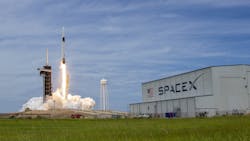Boeing Begins Its Descent and Additive Engineers a Win: 25 in 2025
In our fourth installment of Manufacturing Gamechangers, trends, technology and shifts in the collective psyche begin to take shape that today, years later, have moved from the margins into the mainstream.
The pendulum swings on trade as businessman and reality TV star Donald Trump campaigns on tariffs and wins the presidency in an upset. NASA partners with private space companies like Space-X and Blue Origin, laying the groundwork for commercial space travel. And the Paris Climate Agreement gives CEOs the nudge needed to start looking at sustainability as essential to business growth and cost savings vs. merely abstract, feel-good policy.
Special thanks to IndustryWeek contributors Jamie Flinchbaugh, Christopher Tang, Carolyn Hendrickson, Warren Browne and Lauren Pittelli and former IndustryWeek editors Pat Panchak and Travis Hessman, who all gave us valuable input on the list.
We’d like to hear from our readers as well. Do you have a gamechanger that’s not on the list—or have your own unique list in mind? Or, maybe you just want to relate a memory associated with one of our Gamechangers. Please share with us below.
#16: Space Exploration and Travel Expand
In 2011, NASA ended the space shuttle program but assured the public that the shuttle’s final flight did not mark the end of U.S. space flight. Instead, it signified a historic decision: The time was now for commercial enterprises to head into space.
Said then NASA Administrator Charles Bolden: “We have to get out of the business of owning and operating low-Earth orbit transportation systems and hand that off to the private sector.”
A year later, that hand-off happened. In 2012, Elon Musk’s Space-X became the first privately owned space company to successfully launch and dock its own space capsule with the International Space Station and also demonstrated the potential for commercial enterprises to spur game-changing innovations such as reusable rocket technology. And while Space-X may be the highest-profile name in the space game, it’s by no means the only player. Moreover, space exploration has fueled technology innovations used on manufacturing floors far removed from space, such as visual inspection software originally developed for Martian Rovers now doing quality control on assembly lines.—Jill Jusko
More Manufacturing Gamechangers
#17: Energy Innovation Gets a Boost with the Paris Climate Agreement
Energy reduction goes hand-in-hand with an effective lean-manufacturing operation. But until the unifying push of the Paris Climate Agreement, progress around energy efficiency was fragmented. Companies operating on the global stage had to take action on their own, and rules differed from country to country.
The international treaty adopted in 2015 by 187 countries was a milestone event that gave manufacturers’ energy-saving efforts a meaningful jolt.
The treaty was not a mandate but an impetus for countries to set climate goals and policy around it and have accountability on the world stage. Corporations including Microsoft, Danfoss, Nestle and Johnson Controls signed pledges to honor the agreement and implemented enterprise initiatives to reduce emissions. Reducing energy waste at the plant level increased in importance, with metrics around energy reuse and reduction becoming key performance indicators. The energy pillar in corporate reporting also led to the development of new processes and technologies in energy-efficient equipment and recycling.
When President Donald Trump took office in January 2025, the U.S. quickly pulled out of the Paris Agreement. But with systems in place and a stronger awareness of cost-savings, manufacturers have solid arguments to continue sustainability initiatives.—Laura Putre
#18: Free Trade Loses Its Luster
During his 2016 presidential campaign, Donald Trump called the as-yet-unratified Trans-Pacific Partnership—pushed under President Barack Obama to expedite trade with Asia—a “horrible deal” and said other countries were “ripping off the United States.” His opponent, Hillary Clinton, joined him in criticizing the deal, despite having advocated for the TPP a few years earlier.
Trump won that election on an anti-globalist, anti-free-trade agenda that included renegotiating NAFTA and increasing tariffs on steel and aluminum imports worldwide (and solar panels and medical devices from China alone).
Trump’s Democratic successor, President Joe Biden, not only continued but expanded those tariffs. In 2024, President Trump’s re-election primed the pump for full-scale tariff “dealmaking” with individual countries, sending global manufacturing companies racing to rethink their site locations to minimize their tariff penalties.—Laura Putre
#19: Additive Takes a Practical LEAP
GE’s history with additive manufacturing goes back to the 1980s and the GE Global Research Center in Niskayuna, New York. Things began taking off in 2012 when GE Aviation acquired a small additive company named Morris Technologies, with whom GE Aviation had collaborated since the 1990s. But the projects had always been small-scale, manufacturing limited amounts of parts.
In 2016, GE Aviation acquired two European additive companies, Arcam AB and Concept Laser, and combined them into a new business called GE Additive. That same year, GE Aviation began additively manufacturing the interior of the fuel nozzles for its CFM LEAP engine, taking what had previously required brazing and welding together 20 different parts.
Time Magazine took notice and in an early January 2016 edition cited GE Aviation as an innovator in the manufacturing arena. The new additively manufactured parts were installed in Boeing 737 MAX aircraft among other models.
The practical effects of additive manufacturing therefore arguably began touching more people than ever before and the historical perception of additive manufacturing as a tool primarily for rapid prototyping changed forever.—Dennis Scimeca
#20: The Boeing Debacle Demonstrates That Fundamentals Still Matter
If anyone needed a reminder of the depths to which a company can fall when leadership fails, they found that reminder in Boeing. After two deadly 737 MAX airplane crashes in October 2018 and March 2019 killed 346 people, a narrative began to emerge of a once-storied company that had lost its way. Boeing, the narrative related, valued production speed over quality and safety, deliberately delayed reporting a software problem to the FAA and stepped well over the line in laying off experienced engineers and seeking supplier cost cuts.
What happened to Boeing’s culture that allowed such egregious decisions to be made, not once but over and over until the worst possible outcome became a reality? Such decisions rest with leadership—and by the end of 2019, then CEO Dennis Muilenburg was fired, and the reputation of Boeing was in tatters.
Moreover, quality issues have continued. Manufacturing defects reported in 2021 led to a temporary halt of the 787 Dreamliner, and while missing bolts were cited as among factors behind a door plug that blew out on a 737 MAX-9 jet while the aircraft was in flight.
Fundamentals matter. Leadership matters. Boeing is a stark reminder.—Jill Jusko
About the Author
Jill Jusko
Bio: Jill Jusko is executive editor for IndustryWeek. She has been writing about manufacturing operations leadership for more than 20 years. Her coverage spotlights companies that are in pursuit of world-class results in quality, productivity, cost and other benchmarks by implementing the latest continuous improvement and lean/Six-Sigma strategies. Jill also coordinates IndustryWeek’s Best Plants Awards Program, which annually salutes the leading manufacturing facilities in North America.
Have a story idea? Send it to [email protected].

Laura Putre
Senior Editor, IndustryWeek
As senior editor, Laura Putre works with IndustryWeek's editorial contributors and reports on leadership and the automotive industry as they relate to manufacturing. She joined IndustryWeek in 2015 as a staff writer covering workforce issues.
Prior to IndustryWeek, Laura reported on the healthcare industry and covered local news. She was the editor of the Chicago Journal and a staff writer for Cleveland Scene. Her national bylines include The Guardian, Slate, Pacific-Standard and The Root.
Laura was a National Press Foundation fellow in 2022.
Got a story idea? Reach out to Laura at [email protected]
Dennis Scimeca
Dennis Scimeca is a veteran technology journalist with particular experience in vision system technology, machine learning/artificial intelligence, and augmented/mixed/virtual reality (XR), with bylines in consumer, developer, and B2B outlets.
At IndustryWeek, he covers the competitive advantages gained by manufacturers that deploy proven technologies. If you would like to share your story with IndustryWeek, please contact Dennis at [email protected].
Ryan Secard
Associate Editor
Ryan Secard joined Endeavor B2B in 2020 as a news editor for IndustryWeek. He currently contributes to IW, American Machinist, Foundry Management & Technology, and Plant Services on breaking manufacturing news, new products, plant openings and closures, and labor issues in manufacturing.
Anna Smith
News Editor
News Editor
LinkedIn: https://www.linkedin.com/in/anna-m-smith/
Bio: Anna Smith joined IndustryWeek in 2021. She handles IW’s daily newsletters and breaking news of interest to the manufacturing industry. Anna was previously an editorial assistant at New Equipment Digest, Material Handling & Logistics and other publications.








